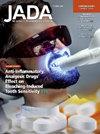Perceptions of the role of dentists in human papillomavirus and COVID-19 vaccinations
IF 3.1
2区 医学
Q1 DENTISTRY, ORAL SURGERY & MEDICINE
引用次数: 0
Abstract
Background
Human papillomavirus (HPV) and COVID-19 are contagious diseases for which effective vaccines exist. Dental care professionals’ involvement in vaccination campaigns for these conditions has been proposed, but there is a lack of understanding of dentists’ roles in vaccination, specifically assessing patients' attitudes around dentists as vaccinators for HPV and COVID-19.
Methods
Using a cross-sectional design and convenience sampling, a 12-item validated survey was distributed to community members to determine perceptions about dentists' roles in vaccination for HPV and COVID-19. Demographic characteristics, vaccination status, knowledge of the diseases, vaccination intentions, and willingness to receive education about, recommendations for, and administration of vaccine from a dentist were assessed. Responses were analyzed using bivariate and multivariate analysis.
Results
Of 618 participants, most were vaccinated previously against HPV and COVID-19 (n = 462 [75.6%] and n = 371 [61.0%], respectively). Participants responded more favorably to dentist involvement in educating, discussing, and administering COVID-19 vaccines than HPV vaccines (P < .05). Participants' knowledge of HPV was found to be low compared with that of COVID-19. There were significant differences across demographic groups, with race most frequently associated with differences in responses to COVID-19 and HPV-related questions.
Conclusions
Formative data to develop interventions to support dentists’ participation in vaccination campaigns are provided. Participants' acceptance of COVID-19 vaccination over HPV vaccination may reflect the public awareness of COVID-19 vs HPV due to daily relevance of this disease, or the lack of knowledge about HPV, particularly its oropharyngeal impacts.
Practical Implications
The authors provide evidence to support dentists' involvement in vaccine education and distribution, expanding previous literature into evaluation of a new disease context (COVID-19). Lack of knowledge of HPV may affect willingness to receive the HPV vaccine, presenting an opportunity for education.
牙医在人类乳头瘤病毒和 COVID-19 疫苗接种中的角色认知:成人横断面验证调查结果。
背景:人乳头瘤病毒(HPV)和COVID-19是传染性疾病,目前已有有效的疫苗。有人建议牙科保健专业人员参与这些疾病的疫苗接种活动,但人们对牙医在疫苗接种中的作用缺乏了解,特别是对牙医作为 HPV 和 COVID-19 疫苗接种者的患者态度缺乏评估:方法:采用横断面设计和方便抽样的方法,向社区成员发放了一份包含 12 个项目的验证调查表,以确定他们对牙医在 HPV 和 COVID-19 疫苗接种中的作用的看法。调查内容包括人口特征、疫苗接种状况、疾病知识、疫苗接种意愿,以及是否愿意接受牙医的疫苗教育、建议和接种。结果:结果:在 618 名参与者中,大多数人以前接种过 HPV 和 COVID-19 疫苗(分别为 462 人 [75.6%] 和 371 人 [61.0%])。与 HPV 疫苗相比,参与者对牙医参与 COVID-19 疫苗的教育、讨论和接种反应更积极(P < .05)。与 COVID-19 相比,参与者对 HPV 的了解较少。不同人口群体之间存在明显差异,种族最常与对 COVID-19 和 HPV 相关问题的回答差异相关:结论:为制定干预措施以支持牙医参与疫苗接种活动提供了形成性数据。参与者对 COVID-19 疫苗接种的接受程度高于 HPV 疫苗接种,这可能反映了公众对 COVID-19 与 HPV 的认识,因为这种疾病与日常工作息息相关,也可能反映了公众对 HPV 缺乏了解,尤其是对其口咽部影响缺乏了解:作者提供了支持牙医参与疫苗教育和分发的证据,将以前的文献扩展到对一种新疾病(COVID-19)的评估。对人类乳头瘤病毒缺乏了解可能会影响接种人类乳头瘤病毒疫苗的意愿,这为教育提供了机会。
本文章由计算机程序翻译,如有差异,请以英文原文为准。
求助全文
约1分钟内获得全文
求助全文
来源期刊

Journal of the American Dental Association
医学-牙科与口腔外科
CiteScore
5.30
自引率
10.30%
发文量
221
审稿时长
34 days
期刊介绍:
There is not a single source or solution to help dentists in their quest for lifelong learning, improving dental practice, and dental well-being. JADA+, along with The Journal of the American Dental Association, is striving to do just that, bringing together practical content covering dentistry topics and procedures to help dentists—both general dentists and specialists—provide better patient care and improve oral health and well-being. This is a work in progress; as we add more content, covering more topics of interest, it will continue to expand, becoming an ever-more essential source of oral health knowledge.
 求助内容:
求助内容: 应助结果提醒方式:
应助结果提醒方式:


